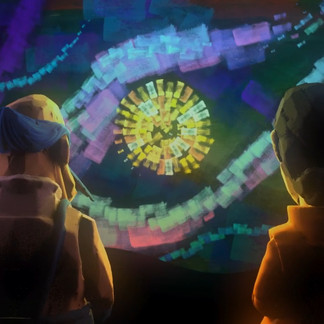Games development is complex and takes a long time. In tough times, it is easy to lose sight of the daily incremental improvements and I would fantasise what it would be like to jump into the future and see the project in its full glory.
This happened with Dreams. In the early days, while the core technology was being worked on, we in the design team focused on concepting ideas. Dreams was super ambitious; building upon the ideas of our previous title, LittleBigPlanet, it too would empower people to create anything from games, to movies and music, with the ability to share them with a global online community. But this time, the tools would take the possibilities of creation much, much further.
With power, however, comes complexity and Dreams had to tread a very fine balance between empowering possibilities whilst remaining accessible and fun to create in. This was mine and Art Director, Kareem’s biggest concern and we worked together to develop a visual metaphor that could strike this balance. Conventional 3D modelling is highly technical; everything is made up of a wire-mesh of digital triangles and materials can be applied to the surfaces by a combination of “mapping” images using “texture coordinates” and shaders that define how objects reflect light. We knew this would alienate most people, so we went back to first principles of how someone might want to create; clay and paint.
But this would be magic paint that would stay up in the air, that would flutter in the wind, that you could control with the flick of your wrist. Underlying this playful simplicity were a number of subtle but important wins. We had shifted the emphasis from realism to expressionism and through this, changed the expectation as to “what is possible” and “what is good”. We had sidestepped the need for extra technical tools that ensure a brick texture would be mapped correctly to a curving wall, instead, the bricks could be simply painted on, like an artist in a theatre set.
But this idea came with a number of major technical challenges for the code team and it lulled while very clever brains mulled. Around this time, I was feeling the need to refresh and learn something new, so I decided to leave the project to pursue a Master’s degree. But four years later, I would return to help with the final push to ship Dreams and I’ll never forget the moment I first saw what they’d achieved. It was the jump into the future that I’d fantasied about.
I half expected for our proposal to be lost along the way, but Kareem, with the help of graphics coder Simon, had persevered and the results were jaw dropping. Immersive, 3D paintings, rippling and alive, it was testimony not only to the technical team but artists like Jon, Emilie and Maya who had totally mastered the tool.
But now, my job far less blue sky, we had a game to ship. “Art’s Dream” was the major playable content that shipped with Dreams. It was more than just a game in its own right; it was a demonstration of what was possible using Dreams’ tools. It was originally conceived as three separate games that would demonstrate a variety of genres in the hope that they would inspire others to have a go themselves. But these three games had been brought together into a single adventure with the intention of showcasing another feature of Dreams: storytelling.
My role was “Integration Manager” to help pull the project together into a cohesive whole. This was particularly challenging given the multiple objectives we were trying to serve. I worked closely with Mark, the Creative Director, Cara the scriptwriter and the Design, Art and Audio teams, reordering and refactoring the meaning of scenes, weaving characters, symbolism and gameplay together. Story affects everything. With little time left, last minute help from writer Nirpal Bhogal brought a new clarity and I still remember the first moment I could feel the project come together as a whole.
Seven years in the making, Dreams was released to much acclaim, but just like LittleBigPlanet, the most satisfying for me was to see what people had done with the tools; not just levels but entire universes and experiences. And the biggest irony of all, people using our expressionist tools, had managed to create scenes so realistic, they are indistinguishable from photos.
Just like before, each time I look, another leap into the future has been made by someone somewhere in the world.
*All images copyright of Sony Interactive Entertainment



































